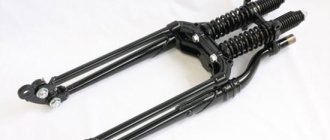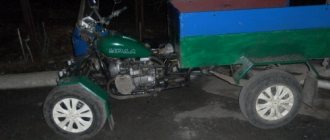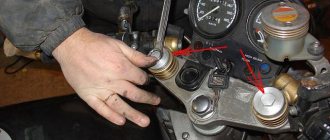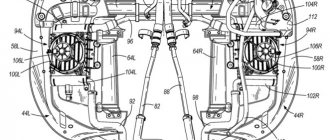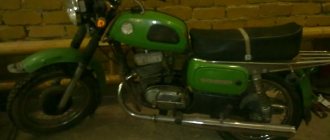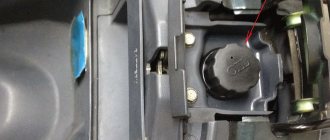Oil viscosity by season
Quantity
So, we all know that oil has several types of viscosity and, probably, this is not just like that. But no one can be convinced, and everyone unanimously shouts “10 W 40!”, “Yes, that’s what it says in our technical book!”
You can listen to what you read now, or you may not... It’s up to you! And the damaged engine will be yours! But still, for novice pit bikers who want to be more or less literate, we will write everything as it is.
Let's start with the fact that everything written, every word was tested from our own experience: we have behind us more than one engine that has been damaged due to ignorance and stupidity, and far from being a Pitovsky one, the repair of which cost 60 thousand rubles more than once. Two Kab engines, similar to Pitov’s, were killed.
We can’t stop talking about your favorite technical book, which you read for God knows what. Well, excuse me, but you can take this book, crumple it up well and go sit on the throne.
Yes, indeed, it says that you need to use oil with a viscosity of 10 W 40 and blah blah blah, BUT! Let's reveal the secret! This regulation is written for ideal operating conditions, a temperature of 20-25 degrees and a perfectly uniform seasonal climate!
Now let's look at what time of year, what oil is best to fill and at what ambient temperature.
Let's start naturally with the height of the season - summer. In the summer, especially in the central part of Russia, the temperature in the shade can go beyond 40 degrees, but in the sun it exceeds this mark and the air engine simply does not have enough oncoming flow of hot air to provide more or less normal cooling. High temperatures outside cause the engine to heat up much more, and your vaunted 10/40 begins to boil over! But this is half the trouble...
Boiling oil gradually evaporates, and judging by the number of breakdowns, you don’t like to keep an eye on the oil level. As a result, oil starvation and a dying piston and cylinder head.
Do you think that's all? But no, the funniest thing is happening with the clutch, which simply slips and burns due to the fact that in the crankcase you no longer have viscous oil, but a substance similar in viscosity to water.
Well, the last one is also quite funny - you stop forming a stable oil film on all parts, and this includes the crankshaft and the gearbox. The valve stem seals burn stupidly from running dry, and then you whine that your piston has run out, that the pit is smoking, and so on. Therefore, at this temperature, use oil with a viscosity of 20 W /50 or 15 W /50.
Time passes, autumn is coming, the temperature outside is on average from 20 to 10 degrees, and now it’s time to start using 10 W / 40. Now it will be just perfect, the oil will hardly boil or evaporate much, the oil film will form very well, and you will not have any problems. The main thing is, don’t forget to keep an eye on the level and everything will be fine!
And yes, it doesn’t matter Motul, Castrol... Everything is mixed from one barrel and stamped under different brands and slightly different additives.
The only thing is that the composition of the scooter is 90% identical and has an almost identical series of additives injected into it. And yes, car oil really would not be suitable, since it is not designed for such high speeds. And the oil film simply would not stick to the parts.
But in deep winter there are trash lovers who race in minus 25-35 degrees.
There are no options at all: you only need to fill in the zero, i.e. 0 W /40. You won’t find this type of oil for motorcycles or scooters; it is used most often on snowmobiles, and that’s what we buy. The oil has a low viscosity at particularly low temperatures, so it can be used in an engine, at least with this oil change algorithm. The Kabovsky 110 engine has been alive for 260 hours and is still quite healthy and vigorous.
By spring, when temperatures are already reaching plus 1, we again pour 10 W 40, and then change according to the algorithm written above.
Result:
If you want to operate your pit bike in any weather conditions, then you should pay great attention to the correct selection of oil. Damaging an engine is a simple matter, but restoring it is time-consuming and expensive.
Source
How to replace fork oil?
To calibrate the oil, a much more sensitive viscosity calibration scale is used, so in practice you can get a conditional 7.5W or 8W “for yourself” by mixing ordinary industrial oils in the required proportions. For the performance of a product under specific operating conditions, it is not the viscosity value itself that is important, but the so-called viscosity index. It is usually indicated on the Saybolt Seconds Universal (SSU) scale at 100°C. Let's assume that the numbers on the container read 85/150. This means that the SSU value of the oil at 100ºC is 85. The oil's viscosity is then measured at 40ºC. The second number - 150 - is the value indicating the difference in flow between the two temperatures, which determines the stated viscosity index.
What does this have to do with motorcycle forks? The friction created by sliding metal parts and oil moving back and forth increases the temperature inside the assembly. The more constant the oil weight remains, the less likely it is that the fork damping will change.
Thus, it is quite possible to replace fork oil with industrial oil, combining its brands according to the operating conditions of your motorcycle.
With certain reservations, this principle can be used for other vehicles (with the exception of racing motorcycles).
Source
What is the best pit bike fork oil?
In the last issue, dedicated to choosing the “right” oil for the fork, a number of mistakes were made, which @4tres rightly pointed out to me, for which many thanks to him.
I also want to say thank you to all the commentators who wrote utter nonsense, and thereby provoked knowledgeable people to object in a reasoned, justified manner and with links to useful materials. Who would have thought that such comments would be useful! In this article, I hope we will be able to finish the topic of fork oil viscosity. So, anyone interested in damping, static and dynamic viscosity, quality oils and liquids, let’s figure it out together.
Viscosity affects damping parameters - error?
Here I made the assumption that since oil manufacturers indicate viscosity in their data sheets, it directly affects the damping parameters. The second assumption was that since my sources compared oils precisely according to this parameter, and did not take into account the density of the oil, then it does not affect anything. As for the first one, yes, but no. But the second one was a fiasco... There are two types of viscosity. Kinematic , which characterizes the speed of fluid flow under the influence of gravity, and dynamic , which precisely determines the viscous friction forces arising in the shock absorber. Kinematic(v) and dynamic(n) viscosities are related by the formula
.
Why oil manufacturers all indicate kinematic viscosity instead of dynamic viscosity, which directly affects the operation of the suspension, is a mystery to me. Perhaps because viscometers determine exactly this, and it’s stupidly simpler this way: you don’t need to recalculate, you don’t need to take into account the density of the liquid.
Well, the density is indicated, take it and multiply it!
Again yes, but no. The density of liquids is known to depend on temperature. The density of the oil, however, depends on temperature quite significantly. Oil workers even, as it turns out, have special conversion tables for this. These tables tell us that: 1) the degree of dependence of density on temperature is linear; 2) as the temperature increases, the density of petroleum products decreases; 3) the higher the oil density, the smaller the temperature correction. The first two points in the context of fork oils mean that, in fact, dynamic viscosity will have an even more pronounced temperature dependence than kinematic one. The third point means that a denser oil with equal dynamic viscosity at a certain point will have less of a change in the effect on the fork’s operating mode when the temperature changes than a less dense one. But in the range in which the density of fork oils lies, changes expressed as a percentage of the original density amount to a few percent. In short, you still need to take into account the density, but you can forget about the temperature... it would be if everyone were normal people and indicated the density at the same temperature, but no, half write the density at 20C, the other half - at 15, so that them. Well, okay, the formulas have already been established, so we’ll survive.
I was going to add density data to the table, I even started doing it. But then I decided to check whether it makes such a big difference? I took the ill-fated Honda oil, for which almost nothing is indicated, and made three examples of curves for dynamic rather than kinematic viscosity: at the maximum density among oils (green), at the minimum (red) and at average, but without taking into account the temperature coefficient of change in density (in orange) and this is what happened:
It turns out that the effect of density on the value of dynamic viscosity will be a maximum of 8%. On the one hand, this, of course, is nonsense, on the other hand, it may turn out that the dynamic viscosity of the oil due to this will be higher than that of the original not by 2 times, but by 2.2, and this will be a reason to refuse what is more different. Well, then, I’ve already started the formulas, why not? One way or another, searching and reading datasheets tired me out quite a bit, so at a certain point I just went and entered the average density for all the oils that I couldn’t find or didn’t want to. Such cells are highlighted in red. For such oils, it turns out that the dynamic viscosity will not be calculated exactly, but with a tolerance of 5 percent. Those who need more accuracy can enter it themselves for the oils of interest.
Does the fork eventually reach operating temperature and remain there? In theory, no.
The argument would be normal if there was a thermostat and a cooling system, but there is nothing like that in the suspensions that I know of. What is there that determines the established temperature regime?
Everything is quite simple: 1) The node in which heat is generated. Actually, these are those parts of the fork where viscous friction and sliding friction occur - heat generation power . 2) The path that heat travels to the surface from which it dissipates into the atmosphere - thermal resistance . 3) The surface from which it is actually scattered is essentially a radiator .
The heat dissipation power (P) inside clearly indicates how the fork behaves at a certain riding speed on a certain surface. It will be directly proportional to the dynamic viscosity, P=kN*n, where kN is a complex coefficient that also takes into account motion conditions. Thermal resistance is a constant value that will determine the temperature difference at steady state, directly proportional to the heat transfer power (T2-T1 = R*P). Well, the power of heat dissipation in steady state will be equal to the power of heat release, and is directly proportional to the area, shape and speed of air flow (kT), as well as the temperature difference between the surface of the fork and the environment T0, P=(T2-T0)*kT.
And so, I’m driving along a broken dirt road at 100 odd kilometers per hour and the only thing I care about is what is my heat output? And the higher it will be, the higher the dynamic viscosity of the oil. Directly proportional to it. In further calculations for thermal resistance, we will completely forget, because the calculation is not to determine the temperature, but to show the significant difference between seemingly identical oils. Let’s say that outside the visor window T0=0C, the oil begins to warm up, and the temperature regime will be as follows: kN*n(T)=T*kT n(T)/T = kT/kN
That is, under the same conditions, no matter what conditions we choose, we get the same ratio of viscosity at a certain temperature to this temperature. Now let’s compare, say, Honda Pro HP Fork Oil (10wt) and MOTUL Fork Oil Expert 10W oil, which have the same SAE classification and even practically the same viscosity at 40C (35.20 and 35.90, respectively) , but different temperature coefficients:
Yes, of course, it would be possible to calculate more accurately, but frankly speaking, I’m lazy.
For me, the result, even with an accuracy of plus or minus 5 degrees, is very significant: the fork will behave differently, and a difference of 20% will be noticeable . Although, in fairness, it must be admitted that less temperature-stable oil will actually reach the temperature regime faster, and then it will heat up more slowly. But it will have its own temperature regime, and not the one we would like, and, moreover, highly dependent on the ambient temperature
